|
Repair
of the First Two Spurs: July 21-27
Summary
The restoration team initiated work on the first
of the two smaller injury areas, Sites "F" and "A."
Working on the smaller sites insured that any
potential problems in the design work or materials
could be quickly addressed. With calm seas, work
proceeded quickly as the contractors, sanctuary
staff, and design engineers developed into an
effective project team.
The
only significant problems were delays in the cement
supply, the "death" of one of the starboard engines
on the sanctuary's vessel, and difficulties with
the cellular phones. The contractor returned the
barge to Stock Island to pick up supplies,
including cement. The sanctuary vessel is getting
two new engines, and the cellular phones now have
new antennae.
Injury
Site "F"
During
the procedure heavy canvas straps secured the
boulders while they were lowered over
the
side
of the barge. The boulders were then guided into
place by divers. After workers placed the boulders
and the initial rebar lattice on the site, they
added several tremie pours. Each pour was mixed in
a concrete mixing truck on the barge and then
pumped off the barge through special hoses.
Divers
placed fiberglass rebar in new concrete about 20
minutes after each pour following the design
drawings. After the final pour of concrete (about
six cubic yards), divers carefully covered the site
with surface rocks, one by one. Their work was
guided by the sanctuary's resource manager, Harold
Hudson. In reef restoration, rocks are placed to
resemble the top of a healthy reef and to provide a
better substrate for coral recruitment.
Injury
Site "A"
The
team shifted the crane position from Site "F" to
Site "A." The first step on Site "A" was the
removal of debris from Hurricane Georges. The
debris was preventing effective placement of the
boulders. The debris was cleared with the clamshell
bucket on the 125 foot crane.
Boulder
placement took several days, after initial chinking
and sealing of the sides of the site. Several
tremie pours were needed, each with a placement of
rebar for support. The final concrete was allowed
to harden enough to support some weight, yet still
be soft enough to move rocks into the concrete.
Surface rocks were then placed by hand (under
Harold Hudson's guidance) into the concrete to give
the finished injury site a coral reef appearance.
This completed the structural portion of Site "A"'s
restoration effort.
Worksite Images
|
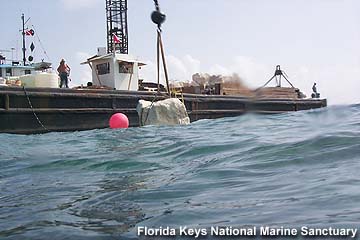
|
|
A
three to five ton boulder entering the
water.
|
|
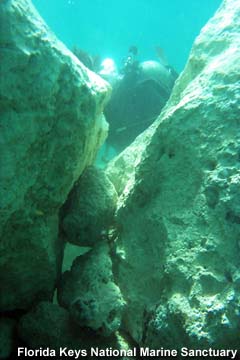
|
|
"Chinking"
stones used to help seal (along with
underwater concrete grout) the perimeter
boulders before tremie concrete pour. Site
"A".
|
|
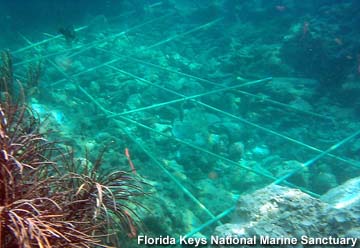
|
|
A
composite rebar lattice for stabilization
of first tremie concrete pour. Site
"A".
|
(top)
|
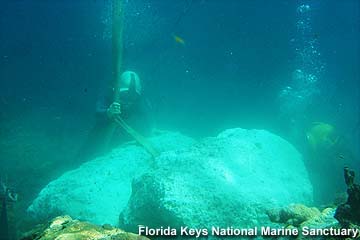
|
|
Divers
setting boulder in Site"F".
|
|
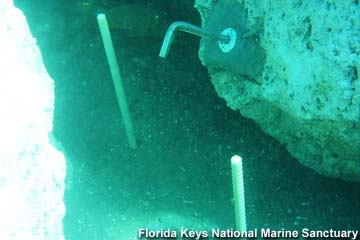
|
|
"Hudson"
holders, like that shown in the boulder
above, are placed in perimeter boulders
for increased stability. Vertical rebar
provides stability between tremie concrete
layers.
|
|
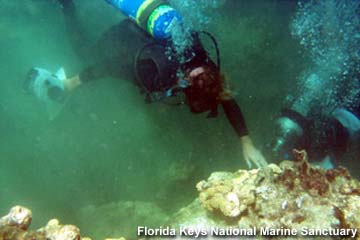
|
|
Divers
from NOAA and Coastal Planning and
Engineering (CPE) checking placement of
boulder at Injury Site "A".
|
|
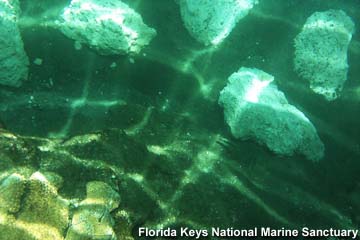
|
|
Partial
placement of top surface rocks in final
tremie pour at Injury Site "F". This is to
facilitate coral recruitment and simulate
the natural surface of the coral
spur.
|
(top)
|

